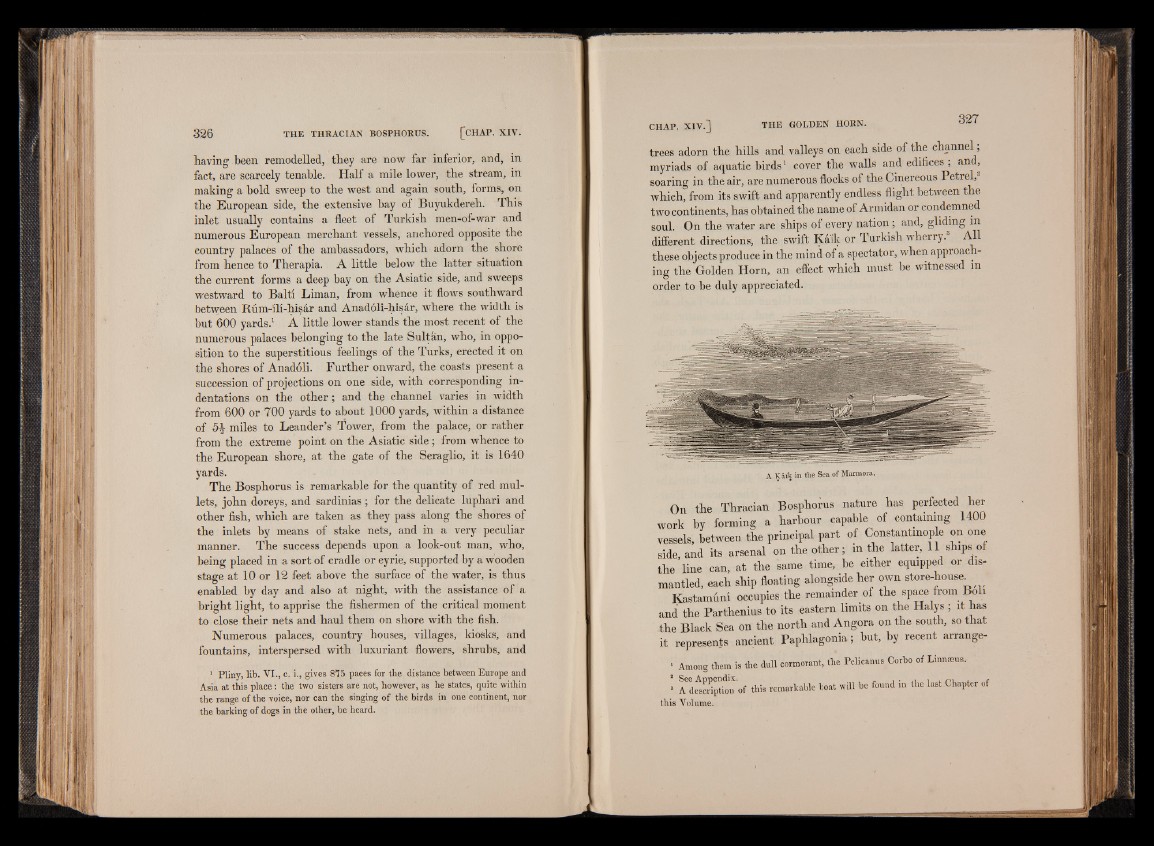
having been remodelled, they are now far inferior, and, in
fact, are scarcely tenable. Half a mile lower, the stream, in
making a bold sweep to the west and again south, forms, on
the European side, the extensive bay of Buyukdereh. This
inlet usually contains a fleet of Turkish men-of-war and
numerous European merchant vessels, anchored opposite the
country palaces of the ambassadors, which adorn the shore
from hence to Therapia. A little below the latter situation
the current forms a deep bay on the Asiatic side, and sweeps
westward to Balti Liman, from whence it flows southward
between Rum-ili-hisar and Anadoli-hisar, where the width is
but 600 yards.1 A little lower stands the most recent of the
numerous palaces belonging to the late Sultan, who, in opposition
to the superstitious feelings of the Turks, erected it on
the shores of Anadoli. Further onward, the coasts present a
succession of projections on one side, with corresponding indentations
on the other; and the channel varies in width
from 600 or 700 yards to about 1000 yards, within a distance
of 5J miles to Leander’s Tower, from the palace, or rather
from the extreme point on the Asiatic side; from whence to
the European shore, at the gate of the Seraglio, it is 1640
yards.
The Bosphorus is remarkable for the quantity of red mullets,
john doreys, and sardinias; for the delicate luphari and
other fish, which are taken as they pass along the shores of
the inlets by means of stake nets, and in a very peculiar
manner. The success depends upon a look-out man, who,
being placed in a sort of cradle or eyrie, supported by a wooden
stage at 10 or 12 feet above the surface of the water, is thus
enabled by day and also at night, with the assistance of a
bright light, to apprise the fishermen of the critical moment
to close their nets and haul them on shore with the fish.
Numerous palaces, country houses, villages, kiosks, and
fountains, interspersed with luxuriant flowers, shrubs, and
1 Pliny, lib. VI., c. i., gives 815 paces for the distance between Europe and
Asia at this place: the two sisters are not, however, as he states, quite within
the range of the voice, nor can the singing of the birds in one continent, nor
the barking of dogs in the other, be heard.
trees adorn the hills and valleys on each side of the channel,
myriads of aquatic birds1 cover the walls and edifices , and,
soaring in the air, are numerous flocks of the Cinereous Petrel,
which, from its swift and apparently endless flight between the
two continents, has obtained the name of Armidan or condemned
soul. On the water are ships of every nation; and, gliding in
different directions, the swift Kaik or Turkish wherry.3 All
these objects produce in the mind of a spectator, when approaching
the Golden Horn, an effect which must be witnessed in
order to be duly appreciated.
A Kaik in the Sea of Marmora.
On the Thracian Bosphorus nature has perfected her
work by forming a harbour capable of containing 1400
vessels, between the principal part of Constantinople on one
side and its arsenal on the other; in the latter, 11 ships of
th e ’line can, at the same time, be either equipped or dismantled,
each ship floating alongside her own storehouse.
Kastamuni occupies the remainder of the space from Boll
and the Parthenius to its eastern limits on the Halys ; it has
the Black Sea on the north and Angora on the south, so that
it represents ancient Paphlagonia; but, by recent arrange-
1 Among them is the dull cormorant, the Pelicanus Corbo of Linnseus, '
8 A LAscrPiption of this remarkable boat will be found in the last .Chapter of
this Volume.